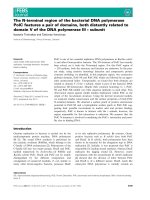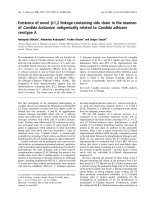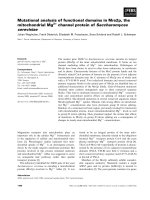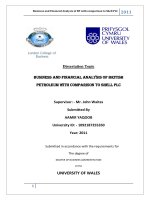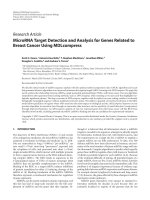Analysis of functional candidate genes related to ubiquitination process for meat quality in commercial pigs
Bạn đang xem bản rút gọn của tài liệu. Xem và tải ngay bản đầy đủ của tài liệu tại đây (17.99 MB, 80 trang )
Leibniz-Institut für Nutztierbiologie (FBN)
Analysis of functional candidate genes
related to ubiquitination process
for meat quality in commercial pigs
Inaugural-Dissertation
zur Erlangung des Grades
Doktor der Ernährungs- und Lebensmittelwissenschaften
(Dr. troph.)
der Landwirtschaftlichen Fakultät
der Rheinischen Friedrich-Wilhelms-Universität Bonn
vorgelegt am 21. August 2013 von
Thi Phuong Loan Huynh
aus Vietnam
Referent:
Prof. Dr. Klaus Wimmers
Korreferent:
Prof. Dr. Peter Stehle
Tag der mündlichen Prüfung:
31.01.2014
Erscheinungsjahr:
2014
Diese Dissertation ist auf dem
Hochschulschriftenserver der ULB Bonn
/>elektronisch publiziert.
Abstract
During the conversion from muscle to meat, the degradation of myofibrillar proteins impacts
on the water holding capacity of meat. Besides the calpain/calpastatin proteolytic system, the
activity of ubiquitin proteasome system also causes the degradation of intermediate filament
proteins and integrins that leads to an increase of drip loss formation in the muscle cells. The
current study sought to evaluate the effects on meat quality of the four functional candidate
genes, UBXN1, UBE3B, TRIP12 and ZRANB1, that related to the ubiquitination processes.
Nine novel polymorphisms were identified in the transcribed and 3´-UTR regions of these
genes. Seven of these novel SNPs were genotyped in a total of about 570 animals derived
from the two populations, German Landrace (GL) and the commercial crossbreed of Pietrain
× (German Large White × German Landrace) (PiF1). The SNPs of the four candidate genes
exhibited strong associations with the indicators of water holding capacity, including muscle
conductivity (UBXN1, UBE3B, TRIP12); drip loss (UBXN1, UBE3B), pH values (UBXN1,
TRIP12 and ZRANB1) and meat redness (UBE3B). The SNPs of the four candidate genes had
also significant association with carcass traits such as loin eye area, loin fat depth and meat to
fat ratio. Moreover, the variation of transcript abundances of UBXN1, ZRANB1 and TRIP12
were significantly associated with the respective polymorphisms. At the same time, their
transcript abundances were correlated with muscle conductivity, pH and drip loss,
respectively. UBE3B transcript abundance was associated with meat redness. The integration
of association and expression data imply the existence of causal polymorphisms in the
i
cis-regulatory regions of these candidate genes, which are in incomplete linkage
disequilibrium with the detected SNPs, and which primarily affect their transcript abundance
and, in consequence, traits related to water holding capacity. Thus the study revealed the
consistent triangular relationship among genotype - phenotype - transcript abundance across
the four candidate genes. In fact, the detected SNPs were in linkage phase with alleles of
causal sites increasing the transcript abundances, and enhancing the purge loss in the case of
UBXN1 and UBE3B, whereas decreasing drip loss formation in the case of TRIP12 and
ZRANB1 genes. Moreover, interactions observed among these genes of the ubiquitination
system and the ryanodine 1 receptor (RYR1) indicate options for further improvement of meat
quality, in particular in RYR1 heterozygous animals, by considering genotypes at these loci.
The results of this study provide genetic evidences to support UBXN1, UBE3B, TRIP12 and
ZRANB1 as the functional candidate genes for water holding capacity of pork.
ii
Kurzbeschreibung
Während der Fleischreifung, wenn Muskel gewebe zu Fleisch wird, so wird die
Wasserbindungskapazität des Gewebes durch den Abbau myofibrillärer Proteine beeinflusst.
Neben dem Calpain/Calpastatin Proteolysesystem ist die Aktivität des Ubiquitin-Systems für
den Abbau von Proteinen der Intermediärfilamente sowie von Integrinen mitverantwortlich.
Dies verursacht einen erhöhten Flüssigkeitsverlust der Muskelzellen. Die vorliegende Studie
versucht,
die
Auswirkungen
von
vier
funktionellen
Kandidatengenen
aus
dem
Ubiquitinierungsprozess, UBXN1, UBE3B, TRIP12 und ZRANB1, auf die Fleischqualität
auszuwerten. Neun neue Polymorphismen wurden in der transskribierten Sequenz sowie im
3’UTR der Gene identifiziert. Sieben dieser neuen SNP wurden in insgesamt etwa 570 Tieren
genotypisiert, die aus zwei Populationen stammen, Deutsche Landrasse (GL) und
Pietrain × (Deutsches Edelschwein × Deutsche Landrasse) (PiF1). Die SNP der vier
Kandidatengene
wiesen
eine
signifikante
Assoziation
mit
Indikatoren
der
Wasserbindungskapazität auf, nämlich der Muskelleitfähigkeit (UBXN1, UBE3B, TRIP12),
dem Flüssigkeitsverlust (Drip) (UBXN1, UBE3B), dem pH-Wert (UBXN1, TRIP12 und
ZRANB1) und der Rotfärbung des Fleisches (UBE3B). Die SNP der vier Kandidatengene
zeigten
zudem
signifikante
Assoziationen
mit
Schlachtkörpermerkmalen
wie
der
Kotelettfläche, Lendenfettdicke und dem Fleisch-Fett Verhältnis. Darüber hinaus war die
Varianz der Transkriptmenge von UBXN1, ZRANB1 and TRIP12 signifikant mit den
jeweiligen
Polymorphismen
korreliart.
Gleichzeitig
war
die
Transkriptmenge
mit
iii
Muskelleitfähigkeit, pH Wert und Flüssigkeitsverlust assoziiert. Die Transkriptmenge von
UBE3B war assoziiert mit der Rotfärbung des Fleisches. Die Zusammenführung von
Assoziations- und Expressionsdaten weist auf die Existenz kausaler Mutationen in den
cis-regulatorischen Regionen der Kandidatengene hin, welche sich in einem unvollständigen
Kopplungsungleichgewicht mit den entdeckten SNP befinden. Diese beeinflussen in erster
Linie die Transkriptmenge und, als Konsequenz, Merkmale der Wasserbindungskapazität. Die
vorliegende Studie demonstiert die konsistente dreiseitige Beziehung zwischen Phänotyp,
Genotyp und Transkriptmenge bei allen vier Kandidatengenen. Tatsächlich befanden sich die
detektierten SNP in einer Kopplungsphase mit Allelen kausaler Mutationen, welche die
Transkriptmenge erhöhen und im Fall von UBXN1 und UBE3B den Flüssigkeitsverlust
erhöhen, wohingegen dieser im Fall von TRIP12 and ZRANB1 verringert wurde. Darüber
hinaus weisen Interaktionen zwischen den Genen des Ubiquitin-Systems und dem Ryanodin 1
Rezeptor (RYR1) auf Möglichkeiten der weitergehenden Verbesserung der Fleischqualität hin,
besonders in RYR1 heterozygoten Tieren, indem der Genotyp an diesen Loci berücksichtigt
wird. Die Ergebnisse dieser Studie unterstützen UBXN1, UBE3B, TRIP12 und ZRANB1 als
funktionellen Kandidatengene für die Wasserbindungskapazität von Schweinefleisch.
iv
Contents
1
1. Introduction
1.1 Genetics affecting pork quality…………………………………………
2
1.2 Source of candidate genes for water holding capacity of pork…………...
2
1.3 The functions of candidate genes involve the mechanism of
ubiquitination/deubiquitination processes……………………………….
3
1.4 Aims of the current study…………………………………………………
6
7
2. Publications
2.1
2.2
2.3
UBXN1 polymorphism and its expression in porcine M. longissimus
dorsi are associated with water holding capacity………………………..
8
Novel SNPs of the porcine TRIP12 are associated with water holding
capacity of meat…………………………………………………………
17
UBE3B and ZRANB1 polymorphisms and transcript abundance are
associated with water holding capacity of porcine M. longissimus dorsi.
27
3. Discussion
35
3.1 A hypothesis to explain the role of ubiquitination pathway impacting on
water holding capacity of pork………………………………………….
35
3.2 The effects of functional candidate genes on the quality of pork………..
37
3.2.1 The analysis of UBXN1……………………………………………
37
v
3.2.2 The analysis of TRIP12…………………………………………….
37
3.2.3 The analysis of UBE3B…………………………………………….
38
3.2.4 The analysis of ZRANB1…………………………………………..
38
3.2.5 Consistent effects of the candidate genes on water holding capacity
of pork……………………………………………………………..
39
3.3 The interaction of RYR1 and candidate genes related to the
ubiquitination process and its effects on meat quality…………………
39
3.3.1 The effects of RYR1 on the meat quality traits…………………...
41
3.3.2 The interactions of candidate genes with RYR1 affect the meat
quality……………………………………………………………...
42
3.4 Implication and Outlook
47
4. Summary
48
List of Figures
52
List of Tables
54
Bibliography
56
Enclosure
vii
1. List of abbreviations
vii
2. Acknowledgement
viii
3. Declaration
ix
4. List of publications and talks
x
vi
1
Introduction
In the past decades, the meat industry sought to increase the profit due to the improvement of
carcass quality that results in the increased carcass weight at reduced production costs. In
order to produce the better carcass quality of pig, the processes lead to the higher incidences
of the halothane gene, and subsequently the deterioration of meat quality such as PSE (pale,
soft, exudative) and DFD (dark, firm, dry) meats. These kinds of pork are not accepted by the
consumers, who feel confident with the meat products that had good economic values as well
as satisfying palatability. Indeed, the attractiveness of pork to consumers depends on its
intrinsic characteristics, such as leanness, taste, odour, tenderness and juiciness. Especially,
the tenderness is assessed as one critical point of preferences of consumers for a better pork
quality. In the pork chain, there are a number of factors that impact on the water holding
capacity of meat and eating quality in certain directions. In particular, the loss of inherent
water retained in muscle cells that occurrs due to the effects of pre-slaughter and post mortem
processes, the drip loss phenomena, causes the incidence of unacceptable tenderness of pork.
Before slaughter, the muscle contraction and metabolism are maintained with the energy
supply of ATP and regulation of Ca2+ channels. In the early post mortem, the muscle tissue
lacks oxygen and the metabolism changes to the anaerobic glycolysis resulting in the
decreased of glycogen and ATP levels in muscle. Correspondingly, the lactic acid is
accumulated to accelerate the rate of pH decline, and consequently leading to the negative
1
effects on meat quality characteristics, including reduced water holding capacity and meat
redness. Moreover, variations in post mortem proteolysis affect meat tenderness during the
conversion of muscle to meat. Indeed, the degree of degradation of cytoskeletal proteins,
which was shown to be associated with the calpain/calpastatin system, cause variation of
water holding capacity of meat. Pigs breeding aims to select animals that had the good quality
of meat with reduced incidence of PSE. However, the performance tests are expensive and
many quality traits are difficult for measurement and/or have low heritability. Molecular
genetic approaches are applied to identify the variation in the DNA-sequence of genes
associated with the increased of drip loss formation. Thereafter, the pork quality will be
improved by the selection towards reduced frequency of unfavoured alleles of these genes in
the commercial pigs.
1.1 Genetics affecting pork quality
The genetic background of pigs is evaluated as a critical factor to explain an appreciable part
of the variation in meat quality (Casteels et al., 1995). It has been widely reported about
several major genes, which involve many biological pathways or mechanisms, that exhibit
strong effects on the meat quality such as: porcine stress syndrome RYR1 (ryanodine
receptor); increasing the glycogen content of the `white´ (fast-glycolytic) muscle types RN
(Rendement Napole); fatty acid binding protein (FABP3, FABP4 and FABP5); insulin-like
growth factors IGF-1 and 2 and leptin and leptin receptor LEPTIN and LEPR (Purslow et al., 2008).
Many studies provide molecular evidences that the degradation of myofibrillar proteins in
muscle related to the calpain system shows strong impact on the variation of meat
characteristics. Indeed, the functional candidate gene, calpastatin (CAST), plays a role as an
inhibitor of calpain and has high impact on the meat tenderness of pork. Moreover, the
interaction between the CAST and the stress susceptibility (halothane gene) exhibit a strong
influence on the water holding capacity of pork, these in turn indicate the combining effects
of the muscle contraction and proteolysis processes on the drip loss formation.
1.2 Source of candidate genes for water holding capacity of pork
The gene expression analysis was performed to investigate the correlation between the
quantitative traits and gene activity within functional networks. Since the last decade, many
researches applied microarrays technique for a gene expression analysis approach to identify
candidate genes for traits related to meat quality. In the previous studies of Ponsuksili and
colleagues, the transcript levels of M. longissimus dorsi were obtained from 72 animals
2
(selected from 572 F2 animals of a crossbreed between Duroc and Pietrain, DuPi population)
using the GeneChip Porcine Genome Arrays. Correspondingly, the transcriptional profiles
and the expression QTL (eQTL) analysis revealed 1,279 transcripts with trait correlated
expression to water holding capacity (Ponsuksili et al., 2008a). The expressions of several
members of the ubiquitin proteasome system were associated with drip loss, conductivity, pH,
or a principle component with high loadings for meat quality traits (Ponsuksili et al., 2009,
Ponsuksili et al., 2010b). The comparison of the transcript levels of two extreme groups of
six discordant sib pairs (selected from 572 animals of DuPi population) that had high
divergence in drip loss (4.14 ± 0.77% vs. 0.9 ± 0.77%, mean ± standard deviation) (p < 0.0001)
provided a number of differentially expressed genes, which are involved in the ubiquitination
process, and that might be responsible for the different drip loss in the individuals
(Ponsuksili et al., 2008b).
During the conversion of living muscle to post mortem meat, the ubiquitin-proteasome is
assessed as one important proteolysis system causing the degradation of myofibrillar proteins
in muscle cell. Thus, the expression studies of Ponsuksili and co-workers provided functional
evidences to illustrate the strong effects of ubiquitin proteasome systems on the quality of
pork. Moreover, the authors also suggested the list of candidate genes for water holding
capacity of meat, in which the subset of genes related to the ubiquitination pathway was
referred. Correspondingly, the four candidate genes in our study were selected from the
source of promising candidate genes, depending on (i) known function of the particular gene
in the ubiquitination process and/or (ii) their genetic positional information of QTL for meat
quality traits.
1.3
The
functions
of
candidate
genes
involve
the
mechanism
of
ubiquitination/deubiquitination processes
The ubiquitin proteasome system has many functions to control the biological events due to
the degradation of specific proteins (Attaix et al., 2002; Lipford et al., 2005). In particular
ubiquitination pathway affects the muscle atrophy, the process of endoplasmic-reticulumassociated degradation as well as regulates the cell adhesion and migration in skeletal muscle
(Jensen et al., 1995; Ward et al., 1995; Taillandier et al., 2004; Huang et al., 2009 and 2010).
Ubiquitination is an ATP-dependent proteolysis process to attach ubiquitin molecule,
Ub - a seventy six amino acid polypeptide - to a protein substrate. In the presence of ATP, Ub
is activated by an Ub-activating enzyme (E1), and is then transferred to one of a number of
Ub-conjugating enzymes (E2s) by trans-thiol esterification. E2 binds the first Ub molecule to
3
protein substrates generating a monoubiquitinated protein. Several E2 are involved in the
formation of polyubiquitinated conjugates due to the continued binding of Ub molecules.
Subsequently, an E2 interacts with Ub-protein ligase (E3) and transfers an Ub molecule to E3,
which is responsible for the recognition of substrates, thereafter an Ub is transferred to the
selected proteins. The tagged proteins containing at least four Ub molecules become a target
of the 26S proteasome for degradation to generate small peptides, and the ubiquitin tail is
cleaved to supply the source of free Ub molecules. The ubiquitination process is disrupted by
deubiquitinating enzymes (DUBs), which play roles to cleave the iso-peptide bonds within Ub
molecule chains and/or between protein substrate and Ub tails, avoiding the destruction of
proteins by 26S proteasome. The ubiquination pathway is shown in the Figure 1.
ATP
ADP+PPi
Ub
E1
Ub
Ub
Ub
Ub
E2
Ub
Peptids
Protein
Protein
E3
26S
DUB
Protein
Ub
Ub
Ub
Ub
Ub
Ub
Ub
Ub
Figure 1: Schematic cycle showing the attachment of a polyubiquitin chain to the protein
substrate and the degradation of tagged proteins by the 26S proteasome
In the current study, four candidate genes of the ubiquin-proteasome system were analysed,
that
encode
proteins
containing
the
specific
domains
playing
roles
in
the
ubiquination/deubiquination processes. Two candidate genes, E3 ligase (UBE3B) and thyroid
hormone receptor interacting protein 12 (TRIP12), function as an E3 enzyme in the
ubiquitination process. In the human genome, HECT and RING are two common types of E3s
that attach Ub to the substrates following different ways (Rotin et al., 2009). The HECT
domain contains the conserved Cys residue in the C-lobe and the E2 binding site in the
N-lobe. It interacts with E2 to form an intermediate thioester bond between a cysteine residue
in the HECT domain and C terminus of Ub molecule. Subsequently, HECT transfers Ub to a
target protein. Otherwise, the RING-finger domain directly transfers Ub from E2 to a protein
4
substrate. A large proportion of E3s belongs to the RING family whereas only 28 E3s are
members of HECT including the two candidate genes, UBE3B and TRIP12.
The linkage between the proteolysis of endoplasmic reticulum (ER) associated proteins and
the regulation of cell adhesion was reported by Darom et al., 2010. Indeed, a conserved E3
ligase RING finger protein (RNF-121), which is expressed in the endoplasmic reticulum (ER)
of cells, targeted a transmembrane glycoprotein (β-integrin) for degradation by 26S
proteasome. The destruction of integrins leads to the formation of drip channels to accelerate
the purge loss in muscle cells. The UBX domain containing protein 1-like gene (UBXN1)
belongs to a UBX domain protein subfamily (SAKS1). It might be considered as an ubiquitin
receptor of the valosin containing protein (VCP) that interacts with E3 ubiquitin ligase to
regulate the ERAD process. In case, the UBXN1 encodes a protein containing a UBA domain
(ubiquitin - associated) and a UBX domain (ubiquitin-like); these domains recruit the
ubiquitinated substrates from ER membrane to the 26S proteasome, avoiding the effects of
deubiquitinating factors. Correspondingly, the UBA domain binds with polyubiquitin chain of
substrate; on the other site the UBX domain interacts with VCP to protect the association of
the VCP with ubiquitinated protein (McNeill et al., 2004; Schuberth et al., 2008; Dikic et al., 2009).
In the opposite aspect, the function of ubiquitin thioesterase (ZRANB1 or TRABID) is to
disrupt the ubiquitination process preventing the degradation of protein substrates by 26S
proteasome. The ZRANB1 consists of an ovarian tumor protease (OTU) domain that is a
subclass of cysteine proteases DUBs (deubiquitinating enzymes). The function of OTU is to
cleave the isopeptide bond within polyubiquitin chain and to remove polyubiquitin signals
from tagged substrates (Nijman et al., 2005; Tran et al., 2008; Komander et al., 2009; Sowa et
al., 2009; Bai et al, 2011; Fushman et al., 2011). The activity of TRABID OTU domain
depends on lysine residues of ubiquitin molecules. Several authors showed that TRABID
cleaved the Lys29- and Lys33-linked diubiquitin more efficient than the Lys63 linkages
(Fushman et al., 2011; Clague et al., 2012 and Licchesi et al., 2012).
5
1.4 Aims of the current study
The objective of the study was to evaluate the effects of functional candidate genes on meat
quality by the identification of polymorphisms in transcribed regions of these four candidate
genes (UBE3B, TRIP12, UBXN1 and ZRANB1), to test for associations of detected SNPs with
the traits related to meat characteristics. Subsequently, we applied the gene expression
analysis to address the variation of transcript abundance of the four genes affecting the
quantitative traits of pork on the one hand, as well as we assessed the relationship between the
transcript abundance and variation at the level of genotype on the other hand. The
combination of two sites might generate the consistent of the three-way relationship among
genotype – phenotype - transcript abundance, to illustrate the existence of causal
polymorphisms in cis-regulatory regions of these functional candidate genes that primarily
influence gene expression and, secondarily, water holding capacity. Integration the results of
association and expression studies provided genetic envidences to support UBE3B, TRIP12,
UBXN1 and ZRANB1 as the funtional candidate genes for pork quality.
The total ca. 570 pigs derived from two populations, including commercial herds of German
Landrace (GL) and Pietrain x (German Large White x German Landrace) (PiF1), were used
for this study. According to in silico analyse of the four genes, seven novels of SNPs were
identified in the coding region; and two SNPs were detected in the 3´-UTR region of UBE3B
gene. Based on the position in the regions with potential function and/or the causing of amino
acid exchanges, seven out of nine polymorphisms were selected for genotyping, association
and expression studies. The effects of these candidate genes on carcass and meat
characteristics are displayed in the following sections.
6
2
Publications
2.1 UBXN1 polymorphism and its expression in porcine M. longissimus dorsi are associated
with water holding capacity
Thi Phuong Loan Huynh, Eduard Muráni, Steffen Maak, Siriluck Ponsuksili, Klaus Wimmers
Research paper published in `Molecular Biology Reports´, (2014): DOI 10.1007/s11033-0132985-5
2.2 Novel SNPs of the porcine TRIP12 are associated with water holding capacity of meat
Thi Phuong Loan Huynh, Eduard Muráni, Steffen Maak, Siriluck Ponsuksili, Klaus Wimmers
Research paper published in `Czech Journal of Animal Science´, 58, 2013 (11): 525–533
2.3 UBE3B and ZRANB1 polymorphisms and transcript abundance are associated with water
holding capacity of porcine M. longissimus dorsi
Thi Phuong Loan Huynh, Eduard Muráni, Steffen Maak, Siriluck Ponsuksili, Klaus Wimmers
Research paper published in `Meat Science´, 95 (2013): 166–172
7
2.1 UBXN1 polymorphism and its expression in porcine M. longissimus dorsi are
associated with water holding capacity
Thi Phuong Loan Huynh, Eduard Muráni, Steffen Maak, Siriluck Ponsuksili, Klaus Wimmers
Molecular Biology Reports 2014, DOI 10.1007/s11033-013-2985-5.
Conceived and designed the experiments: KW SM SP EM. Performed the experiments:
TPLH EM SP KW. Analyzed the data:
TPLH EM SP KW. Contributed
reagents/materials/analysis tools: SM KW SP EM. Wrote the paper: TPLH KW.
8
9
10
11
12
13
14
15



